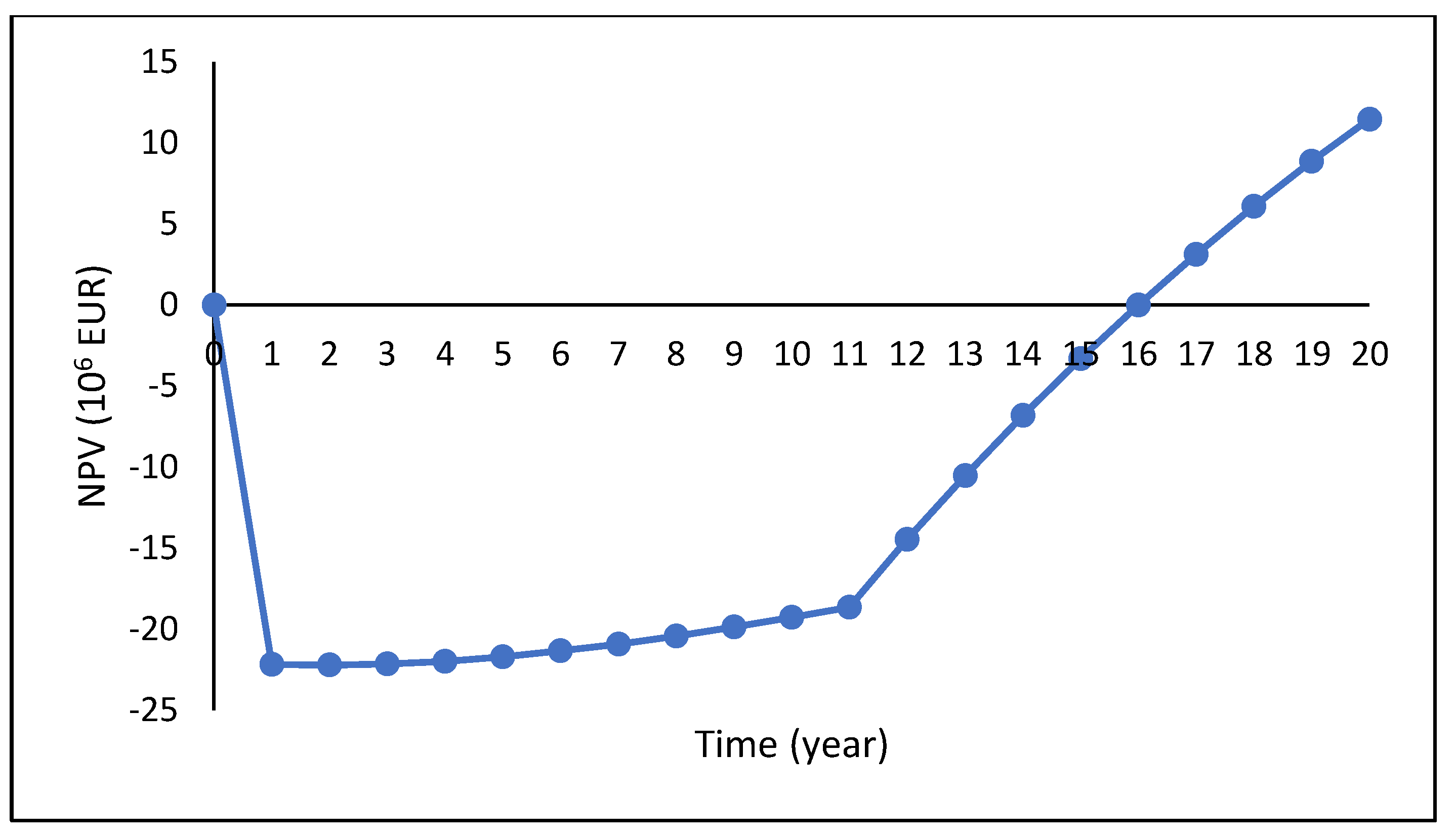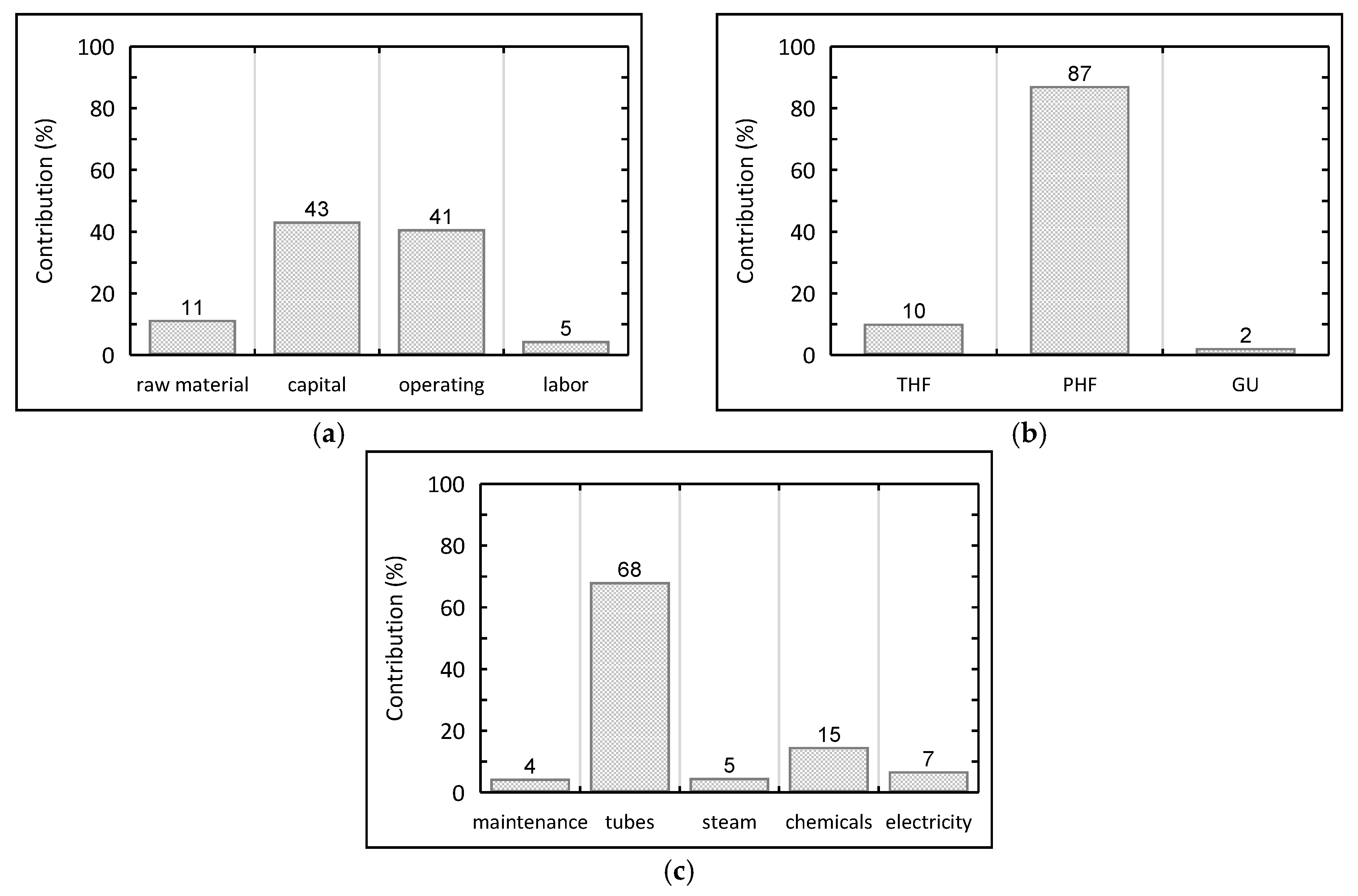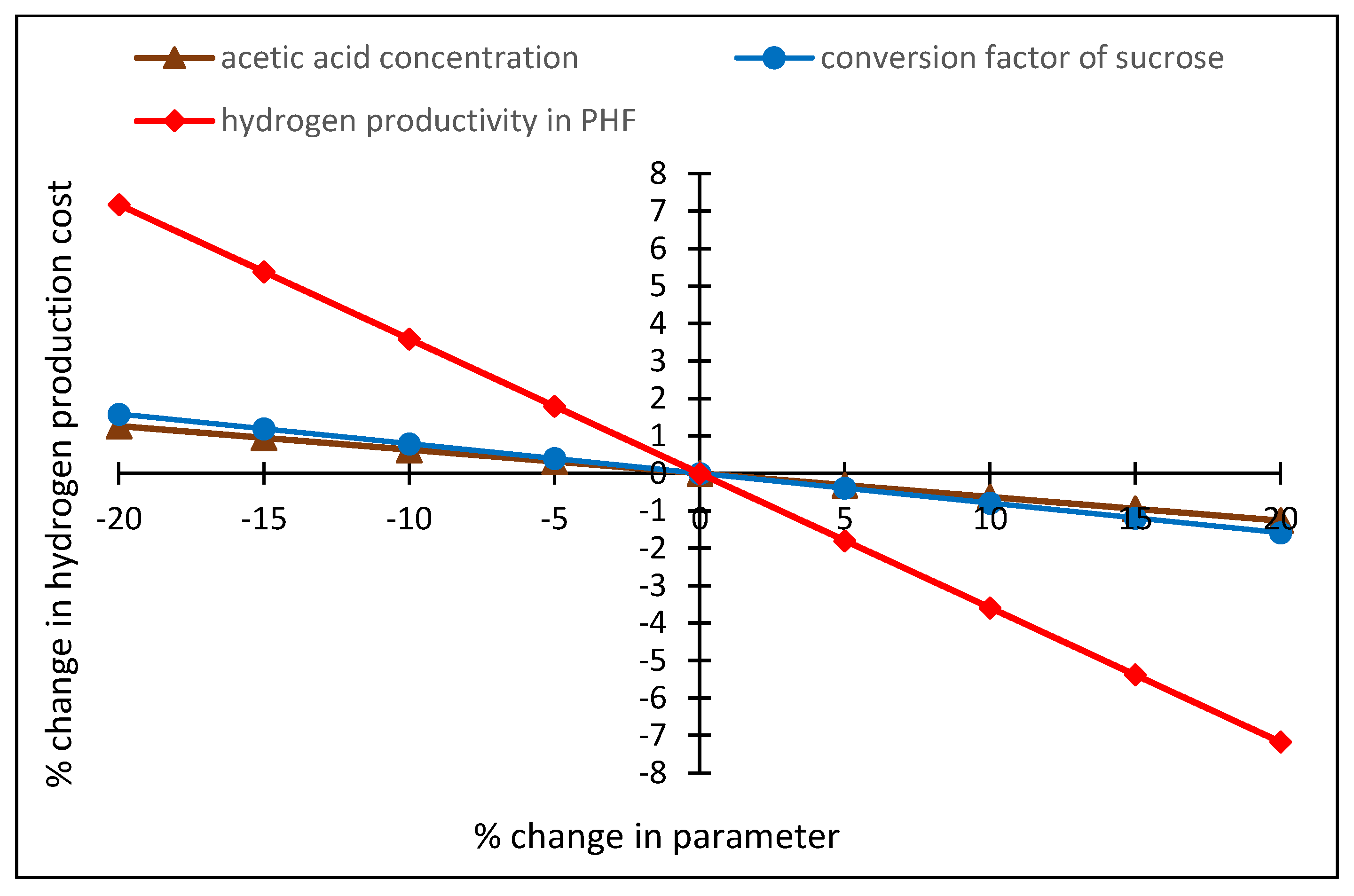Evaluation of the Two-Stage Fermentative Hydrogen Production from Sugar Beet Molasses
Abstract
:1. Introduction
2. Materials and Methods
2.1. Description of the Process
2.2. Process Modelling
3. Results and Discussion
3.1. Process Performance and Plant Characteristics
3.2. Sensitivity Analyses
3.3. Main Directions of Process and Plant Improvements
4. Conclusions
Author Contributions
Funding
Conflicts of Interest
References
- Hu, Y.; Peng, L.; Li, X.; Yao, X.; Lin, H.; Chi, T. A novel evolution tree for analyzing the global energy consumption. Energy 2018, 147, 1177–1187. [Google Scholar] [CrossRef]
- BP Statistical Review of World Energy. 2019. Available online: www.bp.com (accessed on 4 October 2019).
- Zecca, A.; Chiari, L. Fossil-fuel constraints on global warming. Energy Policy 2010, 38, 1–3. [Google Scholar] [CrossRef]
- Ameyaw, B.; Yao, L.; Oppong, A.; Agyema, J. Investigating, forecasting and proposing emission mitigation pathways for CO2 emission from fossil fuel combustion only: A case study of selected countries. Energy Policy 2019, 130, 7–21. [Google Scholar] [CrossRef]
- Li, Y.C.; Liu, Y.F.; Chu, C.Y.; Chang, P.L.; Hsu, C.W.; Lin, P.J.; Wu, S.Y. Techno-economic evaluation of biohydrogen production from wastewater and agricultural waste. Int. J. Hydrogen Energy 2012, 37, 15704–15710. [Google Scholar] [CrossRef]
- Rosen, M.A.; Koohi-Fayegh, S. The prospects for hydrogen as an energy carrier: An overview of hydrogen energy and hydrogen energy systems. Energy Ecol. Environ. 2016, 1, 10–29. [Google Scholar] [CrossRef]
- Yong, J.Y.; Klemeš, J.J.; Varbanov, P.S.; Huisingh, D. Cleaner energy for cleaner production: Modelling, simulation, optimisation and waste management. J. Clean. Prod. 2016, 111, 1–16. [Google Scholar] [CrossRef]
- Azzaro-Pantel, C. Preface Hydrogen Supply Chains: Design, Deployment, and Operation. In Hydrogen Supply Chains; Elsevier: Amsterdam, The Netherlands, 2018. [Google Scholar]
- Claassen, P.A.M.; De Vrije, T.; Koukios, E.; Van Niel, E.; Eroglu, I.; Modigell, M.; Friedl, A.; Wukovits, W.; Ahrer, W. Non-thermal production of pure hydrogen from biomass: Hyvolution. J. Clean. Prod. 2010, 18, 4–8. [Google Scholar] [CrossRef]
- Keskin, T.; Hallenbeck, P.C. Enhancement of Biohydrogen Production by Two-Stage Systems: Dark and Photofermentation. In Biomass Conversion: The Interface of Biotechnology, Chemistry and Materials Science; Springer: Berlin/Heidelberg, Germany, 2012; pp. 313–340. [Google Scholar]
- Panagiotopoulos, J.A.; Bakker, R.R.; De Vrije, T.; Urbaniec, K.; Koukios, E.G.; Claassen, P.A.M. Prospects of utilization of sugar beet carbohydrates for biological hydrogen production in the EU. J. Clean. Prod. 2010, 18, 9–14. [Google Scholar] [CrossRef]
- Urbaniec, K.; Grabarczyk, R. Hydrogen production from sugar beet molasses—A techno-economic study. J. Clean. Prod. 2014, 65, 324–329. [Google Scholar] [CrossRef]
- Tunçay, E.G.; Erguder, T.H.; Eroğlu, İ.; Gündüz, U. Dark fermentative hydrogen production from sucrose and molasses. Int. J. Energy Res. 2017, 41, 1891–1902. [Google Scholar] [CrossRef]
- Gabra, F.A.; Abd-Alla, M.H.; Danial, A.W.; Abdel-Basset, R.; Abdel-Wahab, A.M. Production of biofuel from sugarcane molasses by diazotrophic Bacillus and recycle of spent bacterial biomass as biofertilizer inoculants for oil crops. Biocatal. Agric. Biotechnol. 2019, 19, 101112. [Google Scholar] [CrossRef]
- Kayahan, E.; Eroglu, I.; Koku, H. A compact tubular photobioreactor for outdoor hydrogen production from molasses. Int. J. Hydrogen Energy 2017, 42, 2575–2582. [Google Scholar] [CrossRef]
- Han, W.; Liu, Z.; Fang, J.; Huang, J.; Zhao, H.; Li, Y. Techno-economic analysis of dark fermentative hydrogen production from molasses in a continuous mixed immobilized sludge reactor. J. Clean. Prod. 2016, 127, 567–572. [Google Scholar] [CrossRef]
- EEA. Recent Growth and Knock-on Effects; EEA Report 20/2018: Renewable Energy in Europe—2018; European Environment Agency: Luxembourg, 2018; ISBN 978-92-9480-044-2. [Google Scholar]
- Portal Gospodarczy. Available online: www.wnp.pl (accessed on 10 July 2019).
- International Sugar Organization. Available online: www.isosugar.org/sugarsector/by-products (accessed on 30 March 2019).
- Suedzucker. Available online: www.suedzucker.pl (accessed on 15 April 2019).
- Grabarczyk, R. Techno-Economic Analysis of the Process Plant to Produce Hydrogen by Two-Step Fermentation. Ph.D. Thesis, Warsaw University of Technology, Warsaw, Poland, 2019. (In Polish). [Google Scholar]
- Narodowy Fundusz Ochrony Środowiska i Gospodarki Wodnej. Available online: www.mfosigw.gov.pl (accessed on 8 April 2019).
- Avcioglu, S.G.; Ozgur, E.; Eroglu, I.; Yucel, M.; Gunduz, U. Biohydrogen production in an outdoor panel photobioreactor on dark fermentation effluent of molasses. Int. J. Hydrogen Energy 2011, 36, 11360–11368. [Google Scholar] [CrossRef]
- Uyar, B.; Gürgan, M.; Özgür, E.; Gündüz, U.; Yücel, M.; Eroglu, I. Hydrogen production by hup-mutant and wild-type strains of Rhodobacter capsulatus from dark fermentation effluent of sugar beet thick juice in batch and continuous photobioreactors. Bioprocess. Biosyst. Eng. 2015, 38, 1935–1942. [Google Scholar] [CrossRef] [PubMed]
- Ljunggren, M.; Zacchi, G. Techno-economic evaluation of a two-step biological process for hydrogen production. Biotechnol. Prog. 2010, 26, 496–504. [Google Scholar] [CrossRef] [PubMed]
- Markowski, M.; Urbaniec, K.; Budek, A.; Wukovits, W.; Friedl, A.; Ljunggren, M.; Zacchi, G. Heat Integration of a Fermentation-Based Hydrogen Plant Connected with Sugar Factory. In Proceedings of the Chemical Engineering Transactions; Italian Association of Chemical Engineering—AIDIC: Rome, Italy, 2009; Volume 18, pp. 351–356. [Google Scholar]
- Kumar, G.; Shobana, S.; Nagarajan, D.; Lee, D.J.; Lee, K.S.; Lin, C.Y.; Chen, C.Y.; Chang, J.S. Biomass based hydrogen production by dark fermentation—Recent trends and opportunities for greener processes. Curr. Opin. Biotechnol. 2018, 50, 136–145. [Google Scholar] [CrossRef]
- Markowski, M.; Urbaniec, K.; Budek, A.; Trafczyski, M.; Wukovits, W.; Friedl, A.; Ljunggren, M.; Zacchi, G. Estimation of energy demand of fermentation-based hydrogen production. J. Clean. Prod. 2010, 18, 81–87. [Google Scholar] [CrossRef]
- Modigell, M.; Schumacher, M.; Beggel, F.; Guichard, J.; Sequeira, S.E.; Teplyakov, V.V.; Zenkevitch, V.B. Evaluation of different gas upgrading technologies in biohydrogen production processes. In Proceedings of the CHISA 2008—18th International Congress of Chemical and Process Engineering, Prague, Czech Republic, 24–28 August 2008. [Google Scholar]
- Özgür, E.; Mars, A.E.; Peksel, B.; Louwerse, A.; Yücel, M.; Gündüz, U.; Claassen, P.A.M.; Eroǧlu, I. Biohydrogen production from beet molasses by sequential dark and photofermentation. Int. J. Hydrogen Energy 2010, 35, 511–517. [Google Scholar] [CrossRef]
- Brown, T. Engineering Economics. In Engineering Economics and Economic Design for Process Engineers; CRC Press: Boca Raton, FL, USA, 2006; ISBN 9780849382123. [Google Scholar]
- Turton, R.; Bailie, R.C.; Whiting, W.B.; Shaeiwitz, J.A. Analysis, Synthesis and Design of Chemical Processes, 3rd ed.; Prentice Hall: New York, NY, USA; London, UK, 2009; ISBN 9780135129661. [Google Scholar]
- Smith, R. Chemical Process Design and Integration, 2nd ed.; John Wiley & Sons: Chichester, UK, 2016; ISBN 1118699084. [Google Scholar]
- DOE. Engineering Economic Analysis Guide: Liquid Fuels Technologies; U.S. Department of Energy: Washington, DC, USA, 2015.
- Pfeifer & Langen Poland. Available online: www.diamant.pl (accessed on 6 February 2019).
- Energa. Available online: www.energa.pl (accessed on 6 February 2019).
- Główny Urząd Statysytczny. Available online: Stat.gov.pl (accessed on 6 February 2019).
- Glenk, G.; Reichelstein, S. Economics of converting renewable power to hydrogen. Nat. Energy 2019, 4, 216–222. [Google Scholar] [CrossRef]
- Claassen, P. Non-thermal production of pure hydrogen from biomass—EU FP6-SES Integrated Project Hyvolution. In Proceedings of the World Hydrogen Energy Conference, Essen, Germany, 16–21 May 2010. [Google Scholar]
- Kayahan, E.; Eroglu, I.; Koku, H. Design of an outdoor stacked—Tubular reactor for biological hydrogen production. Int. J. Hydrogen Energy 2016, 41, 19357–19366. [Google Scholar] [CrossRef]










| Price or Specific Cost | Value | Unit |
|---|---|---|
| Molasses | 126 | EUR/t |
| Electric energy | 0.13 | EUR/kWh |
| Steam, 200 kPa | 24.2 | EUR/t |
| Cooling water | 0.017 | EUR/t |
| Potassium hydroxide | 148 | EUR/t |
| Phosphates | 509 | EUR/t |
| Molecular sieve 13X | 3000 | EUR/t |
| LDPE tube | 1.16 | EUR/m |
| Labor skilled/unskilled | 13,760/6720 | EUR/man-year |
| Land | 6270 | EUR/ha |
| Process Parameter | Value | Unit |
|---|---|---|
| Thermophilic fermentation | ||
| Sucrose concentration | 10 | g/L |
| Hydrogen productivity | 16.3 | mmol/L/h |
| Conversion factor of sucrose | 70 | % |
| Photofermentation | ||
| Acetic acid concentration | 40 | mmol/L |
| Hydrogen productivity | 0.5 | mmol/L/h |
| Conversion factor of acetic acid | 45 | % |
| Parameter | Value | Unit |
|---|---|---|
| Molasses demand | 1545 | kg/h |
| Thermophilic fermentation (continuous operation) | ||
| Hydraulic retention time | 10 | h |
| Hydrogen stream | 26.1 | kg/h |
| Bioreactor volume | 2 × 530 | m3 |
| External recycling stream | 88.8 | m3/h |
| Photofermentation (operation 10 h per day) | ||
| Hydraulic retention time | 144 | h |
| Hydrogen stream | 95.7 | kg/h |
| Land area of photobioreactor | 250 | ha |
| Internal recycling stream | 475 | m3/h |
© 2019 by the authors. Licensee MDPI, Basel, Switzerland. This article is an open access article distributed under the terms and conditions of the Creative Commons Attribution (CC BY) license (http://creativecommons.org/licenses/by/4.0/).
Share and Cite
Grabarczyk, R.; Urbaniec, K.; Wernik, J.; Trafczynski, M. Evaluation of the Two-Stage Fermentative Hydrogen Production from Sugar Beet Molasses. Energies 2019, 12, 4090. https://doi.org/10.3390/en12214090
Grabarczyk R, Urbaniec K, Wernik J, Trafczynski M. Evaluation of the Two-Stage Fermentative Hydrogen Production from Sugar Beet Molasses. Energies. 2019; 12(21):4090. https://doi.org/10.3390/en12214090
Chicago/Turabian StyleGrabarczyk, Robert, Krzysztof Urbaniec, Jacek Wernik, and Marian Trafczynski. 2019. "Evaluation of the Two-Stage Fermentative Hydrogen Production from Sugar Beet Molasses" Energies 12, no. 21: 4090. https://doi.org/10.3390/en12214090
APA StyleGrabarczyk, R., Urbaniec, K., Wernik, J., & Trafczynski, M. (2019). Evaluation of the Two-Stage Fermentative Hydrogen Production from Sugar Beet Molasses. Energies, 12(21), 4090. https://doi.org/10.3390/en12214090







